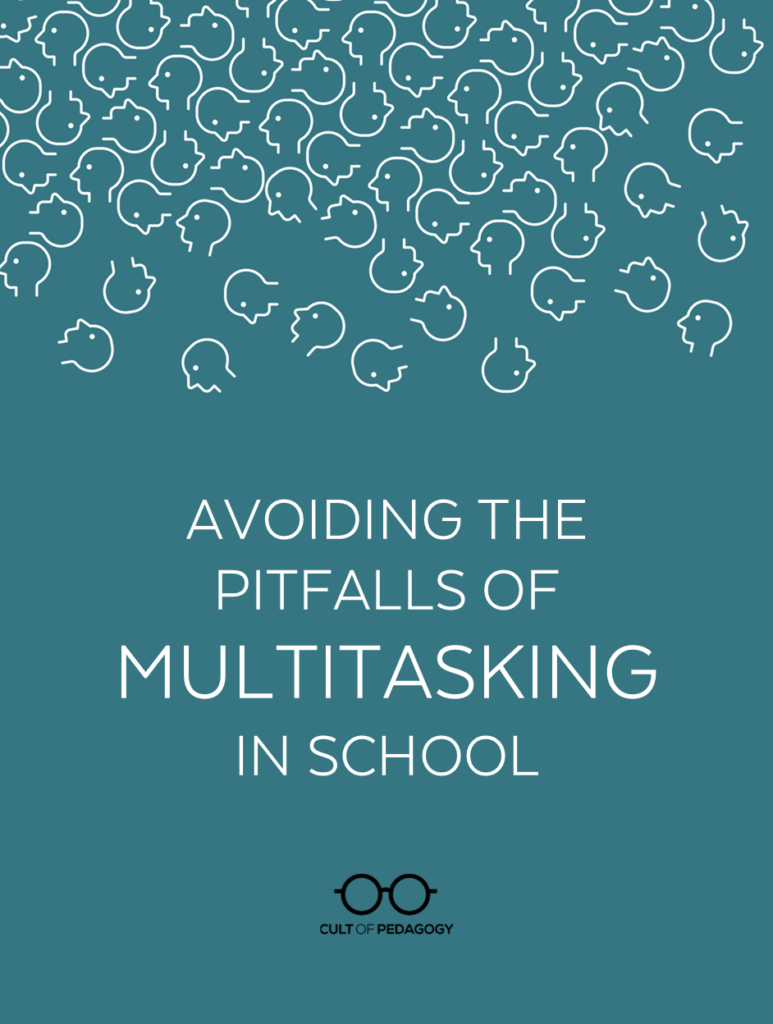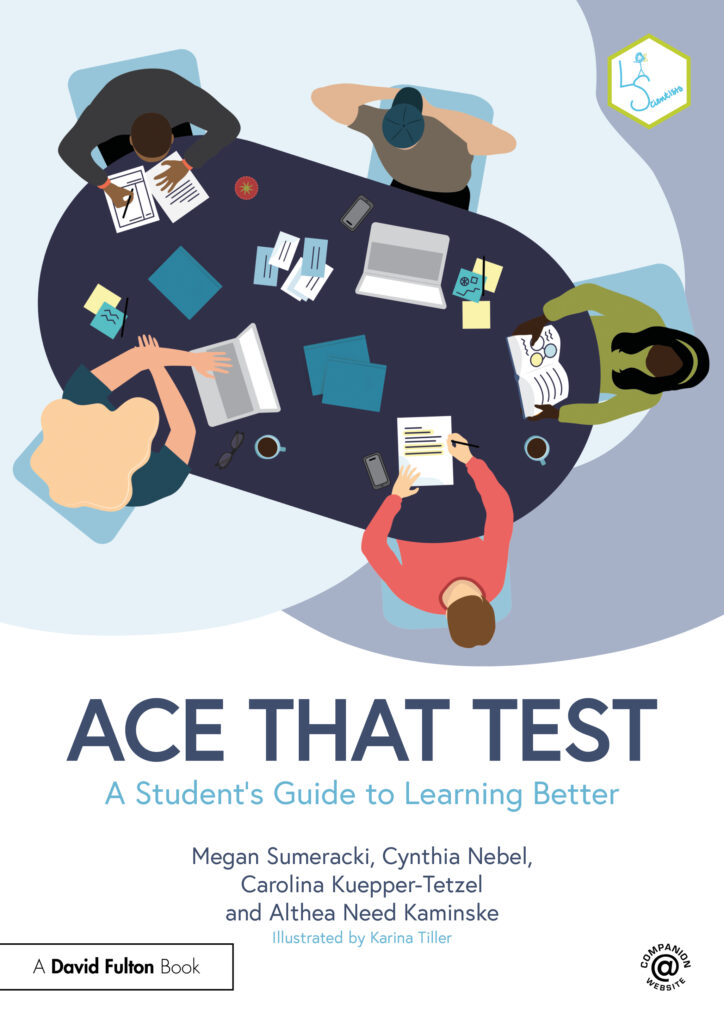Avoiding the Pitfalls of Multitasking in School
Multitasking sneaks into our classrooms and interferes with learning, and it happens in ways you may not even notice. The post Avoiding the Pitfalls of Multitasking in School first appeared on Cult of Pedagogy.


Listen to my interview with Megan Sumeracki (transcript):
Sponsored by Alpaca and The Gilder Lehrman Institute
This page contains Amazon Affiliate and Bookshop.org links. When you make a purchase through these links, Cult of Pedagogy gets a small percentage of the sale at no extra cost to you. What’s the difference between Amazon and Bookshop.org?
While many people have probably gotten the memo that multitasking isn’t great for our brains, strains our mental health, and ultimately doesn’t even work, that’s not stopping a whole lot of us from trying to do it all the time. Sometimes this isn’t a huge deal — it might make us irritable or reduce our productivity. But other times it could threaten our relationships — alienating friends and family who struggle to get our full attention — or even our safety, like when we try to multitask while driving.
Most of this has been pretty widely publicized by now, but multitasking also sneaks into our classrooms and interferes with learning, and it’s happening in ways you might not even recognize. In today’s episode, I’m talking about this problem with cognitive scientist Megan Sumeracki.

Megan is the co-author of the book Ace That Test: A Student’s Guide to Learning Better (Amazon | Bookshop.org), and a team member on the fantastic site The Learning Scientists, where a group of scientists share all kinds of useful information about how we learn. She was also my guest on episode 232 about metacognition. On the podcast, Megan talked to me about some of the sneaky ways multitasking creates pitfalls in schools, and what we can do to avoid them. You can listen to the full episode in the player above, or read the transcript. Below is a summary of our conversation.
Why Multitasking is a Myth
“To really understand the myth of multitasking,” Sumeracki explains, “we need to understand the difference between automatic and controlled processes. It’s really the difference between a conscious effort to do something, where our mental resources are focused on the thing that we are doing. And then doing something more unconscious without that controlled attention. And so we can do two things at once. We can multitask in a way, but only if we’re automatizing one or both of them.”
She offers a few examples of situations where a controlled process is combined with an automatized one: “I can blow dry my hair in the morning and brainstorm examples that I could use in my class that day. Blow-drying my hair is automatic and really doesn’t require conscious attention. And then as I’m thinking about examples, that’s where my main focus is. And so in that way, I am ‘multitasking’ because one is automatized. I can listen to a podcast and take a walk at the same time. Walking doesn’t really require conscious attention. I can do that automatically. I can fold laundry and I can watch TV at the same time.”
The trouble starts, she says, when we try to do two processes that require attentional control at the same time.
“If we’re doing two things that require attentional control, one of two things is going to happen. One is that one thing ends up on autopilot and doesn’t really get processing attention when it should. So I can’t prepare for my class and listen to a podcast story at the same time. What’s going to happen is I’m not actually going to listen to the podcast story or I’m not actually going to fully prepare for my class.
“The other thing that could happen is I end up switching back and forth,” she says. “Switching back and forth is not the same as doing things at the same time. There’s a cost.”
This cost has serious consequences when it comes to things like driving, which we often mistake as an automatized task. “We can automatize our driving,” she explains, “But we cannot automatize the focus we need to catch things out of the norm. So as long as everything works exactly the way we expect it to work, going on autopilot’s okay. But that’s not necessarily going to be true, right? And so when we’re texting and driving, we are rapidly switching back and forth between attending to the road and texting. And if something comes out in front of you or if someone stops in front of you or any of these things while your attention happens to be shifted to the text, then you’re going to be in big trouble.”
How Multitasking Sneaks into School
“A lot of the things that we need to do in school are controlled or should be controlled,” Sumeracki says. “They take conscious effort.” Despite that, some common classroom activities put students in a position where they have to multitask, where their attention is divided.
Round-Robin “Performances”
Any activity that requires students to “perform” something one after another, like round-robin reading, is supposed to give the whole class a shared experience in which everyone pays attention to the student who is speaking. What often happens, though, is that all the students who are not currently reading are counting paragraphs, mentally rehearsing their part, or just feeling nervous about reading in front of the class. What they are usually not doing is listening deeply to the text.
“Your brain is focused on this task of reading the other paragraph,” Sumeracki says. “You don’t hear what everybody else is saying. If the purpose of reading out loud is to practice speaking aloud, to practice reading, maybe that’s okay. We’re really just all taking turns practicing. But if we’re supposed to remember and try to understand the content of what’s being read then that’s not going to work.”
Another example is any icebreaker where students take turns sharing something about themselves, especially if they have to be creative about it.
“If I have to think of a fun thing about myself or, you know, come up with two truths and a lie or something,” Sumeracki says, “I am spending all of my cognitive focus trying to figure out what those things are. I guess maybe in advance I could think about it and maybe I should just have one ready. But I don’t. I don’t have a ‘fun thing.’ I’m always trying to decide which of two things that are loosely fun and mostly boring I should actually say out loud. And then I’m focused on that, and I don’t hear anybody else’s names. Even if I go first, I’m kicking myself over which one I practiced for the next three people. I don’t know who the people are.”
(By the way, I have ideas for much better icebreakers that don’t require you to have a fun thing.)
Forcing Reading, Writing, and Listening into One Space
If we aren’t careful, we can easily slip into teaching routines that force students to multitask, making them choose between reading, writing, or listening at the expense of one of the other things.
One common scenario where this happens is giving lectures.
“A lot of times we’ll say, Oh, PowerPoints are not the best way to engage students,” Sumeracki says. “And the PowerPoint isn’t necessarily the problem. Part of the problem is if we’ve got a bunch of bulleted words, and I’m supposed to be reading but also listening, that can be really tricky.”
If students are also required to take notes on top of the listening and reading, that adds a third cognitive task. “It’s better to put things into your own words, but if you’re trying to listen and watch and look at visuals and you’re trying to put things into your own words and quick jot it down…there’s just so many things going on that it’s very, very difficult.”
Device Distraction
Ok, this is obvious. But it’s an oversimplification to say “kids are always on their phones” and leave it at that. Even having the phones nearby can create enough of a distraction to mess with our concentration, and that can happen in school just as often as it does everywhere else.
“When there’s a phone around,” Sumeracki explains, “there’s some research showing that even the notification going off is enough to pull your attention. So again, it’s not just when you’re looking at it. It’s not just when you have it in your hand and your eyes are on the screen. If you’re thinking, I wonder what that is? Even if it’s not your notification, even if it’s someone else’s, it pulls your focus away. And that can cause problems.”
Strategies that Reduce Multitasking in the Classroom
- Explain the science to students. Help students understand that multitasking is a myth — teach them the difference between automatic and controlled processes and the cost of trying to multitask. Just raising this awareness and encouraging students to try to avoid multitasking can go a long way.
- Structure activities for one task at a time. Avoid setting students up so they have to choose listening or reading slides, for example. Instead, tell students you’re going to give them a few minutes of quiet to read a handout, for example, before explaining it and taking questions.
- Plan cognitive breaks (especially for phones). Sumeracki has found if she gives her college students planned breaks to check their phones, it can significantly improve their ability to focus (and leave their phones alone) during the rest of class.
Remembering the Value of Mind Wandering
Before we wrapped up our conversation, Sumeracki took a moment to point out that having laser-focused attention 100 percent of the time may not be the ideal goal.
“Letting your mind wander every once in a while is not always bad,” she says. “There’s some research showing that when you mind wander, sometimes creative problem-solving can fall out of it. We absolutely do need to focus sometimes, and it’s good to practice that focus, but letting our minds wander sometimes and not being too rigid about exactly what we need to focus on at any given moment can be okay, and giving some time for creative thought or brainstorming or even just a little bit of mind wandering is not always a bad thing either.”
Join our mailing list and get weekly tips, tools, and inspiration that will make your teaching more effective and fun. You’ll get access to our members-only library of free downloads, including 20 Ways to Cut Your Grading Time in Half, the e-booklet that has helped thousands of teachers save time on grading. Over 50,000 teachers have already joined—come on in.
What's Your Reaction?






























.jpg?width=1920&height=1920&fit=bounds&quality=80&format=jpg&auto=webp#)





















































